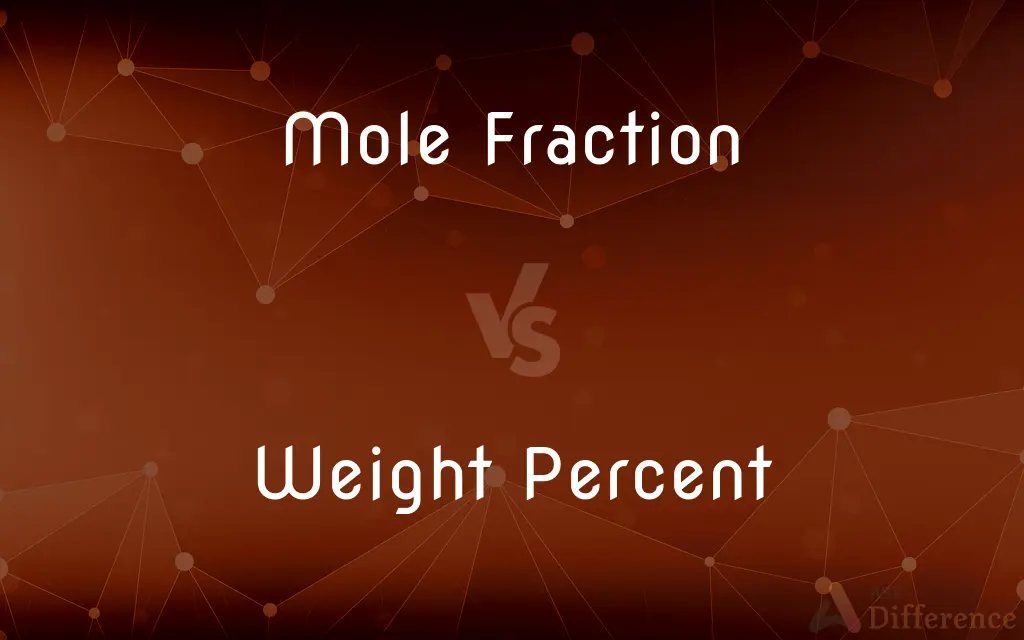Mole Fraction vs. Weight Percent — What's the Difference?
By Tayyaba Rehman — Published on November 23, 2023
Mole Fraction vs. Weight Percent: Mole Fraction is the ratio of moles of a component to the total moles in a solution. Weight Percent is the weight of a component expressed as a percentage of the total weight.

Difference Between Mole Fraction and Weight Percent
Table of Contents
ADVERTISEMENT
Key Differences
The concept of Mole Fraction and Weight Percent plays a crucial role in chemistry, especially when discussing the composition of mixtures. Mole Fraction refers to the ratio of moles of a given component to the total moles in a mixture. This dimensionless quantity provides insight into the amount of each component present on a molecular scale. On the other hand, Weight Percent, often denoted as wt%, quantifies the proportion of a component based on its weight compared to the total weight of the mixture.
Mole Fraction and Weight Percent can both be used to describe the concentration of a component in a mixture. While the Mole Fraction gives a molar perspective, showcasing the fraction of one component's moles to the mixture's total moles, Weight Percent provides a mass perspective, indicating how much of the total mass a particular component constitutes.
It's essential to understand when to use Mole Fraction and when to use Weight Percent. Mole Fraction can be especially useful when considering reactions and stoichiometry, as reactions often proceed on a mole-to-mole basis. Conversely, Weight Percent is more commonly applied in industries where the mass or weight of materials is of primary concern, such as in formulations or product specifications.
Both Mole Fraction and Weight Percent provide ways to express the composition of mixtures. However, their fundamental difference lies in their basis: Mole Fraction is moles-based while Weight Percent is weight-based. It's crucial to select the appropriate metric based on the context and requirements of a given situation.
Comparison Chart
Basis
Based on the number of moles.
Based on weight or mass.
ADVERTISEMENT
Units
Dimensionless (ratio).
Expressed as a percentage (%).
Application in Reactions
Often used in stoichiometry.
Less commonly used in stoichiometric calculations.
Common Use
In gas mixtures and solutions where molar ratios are important.
In industries concerned with the weight of components in mixtures.
Relation to Concentration
Gives a molar perspective of concentration.
Gives a mass perspective of concentration.
Compare with Definitions
Mole Fraction
The ratio of moles of a particular substance to the total moles present.
The Mole Fraction can change when components are added or removed from a mixture.
Weight Percent
A measure of a component's weight relative to the total weight, expressed as a percentage.
The Weight Percent of salt in the solution was found to be 5%.
Mole Fraction
A measure used to express the concentration of a component in molar terms.
By knowing the Mole Fraction of a gas in a mixture, we can predict its behavior.
Weight Percent
Represents the concentration of a component based on its weight.
Weight Percent is crucial in industries to ensure proper formulation.
Mole Fraction
A ratio of the moles of one component to the total moles in a mixture.
The Mole Fraction of oxygen in air is about 0.21.
Weight Percent
A metric indicating how much mass a component constitutes in a mixture.
The alloy's durability depends on the Weight Percent of its constituents.
Mole Fraction
A dimensionless quantity representing a component's proportion in a mixture.
Given the Mole Fraction, we can determine the molar distribution of substances.
Weight Percent
The fraction of a component's weight to the mixture's total weight.
To maintain quality, the Weight Percent of each ingredient is checked.
Mole Fraction
The fraction of moles of a specific component in a mixture.
The Mole Fraction of solute in a solution can help determine its concentration.
Weight Percent
A way to express a component's mass as a fraction of the mixture's total mass.
The Weight Percent of water in the product was less than 1%.
Common Curiosities
When is Weight Percent typically applied?
Weight Percent is often used in industries where the weight of components in mixtures is essential, such as in product specifications.
When should I use Mole Fraction?
Use Mole Fraction when considering molar ratios or when involved in stoichiometric calculations.
What is the Mole Fraction?
Mole Fraction is the ratio of moles of a specific component to the total moles in a mixture.
What are the units of Weight Percent?
Weight Percent is expressed as a percentage (%).
How is Weight Percent calculated?
Weight Percent is calculated as (weight of the component/total weight of the mixture) x 100%.
Does Mole Fraction consider the nature of molecules?
No, Mole Fraction is purely a ratio and doesn't account for the nature or type of molecules.
Is the sum of all Mole Fractions in a mixture always one?
Yes, the sum of Mole Fractions in a mixture always equals one.
How does Weight Percent differ from Mole Fraction?
Weight Percent is based on weight, whereas Mole Fraction is based on the number of moles.
Can Mole Fraction values be greater than one?
No, Mole Fraction values range from 0 to 1.
Which is more commonly used in gas mixtures: Mole Fraction or Weight Percent?
Mole Fraction is more commonly used for gas mixtures.
Can I convert Mole Fraction to Weight Percent directly?
Yes, but it requires the molecular weights of the components and some calculations.
Why is Weight Percent important in industries?
Weight Percent helps industries ensure the proper weight of each ingredient in a mixture or product.
Can Weight Percent values exceed 100%?
No, Weight Percent values range from 0% to 100%.
Which is more useful for chemical reactions: Mole Fraction or Weight Percent?
Mole Fraction is often more useful for chemical reactions as they often proceed on a mole-to-mole basis.
In which scenarios would I prioritize using Weight Percent over Mole Fraction?
Prioritize using Weight Percent when dealing with product formulations, industrial processes, or scenarios where the mass of components is more relevant than their molar quantities.
Share Your Discovery

Previous Comparison
Cane Corso vs. Mastiff
Next Comparison
Active Attack vs. Passive AttackAuthor Spotlight
Written by
Tayyaba RehmanTayyaba Rehman is a distinguished writer, currently serving as a primary contributor to askdifference.com. As a researcher in semantics and etymology, Tayyaba's passion for the complexity of languages and their distinctions has found a perfect home on the platform. Tayyaba delves into the intricacies of language, distinguishing between commonly confused words and phrases, thereby providing clarity for readers worldwide.












































